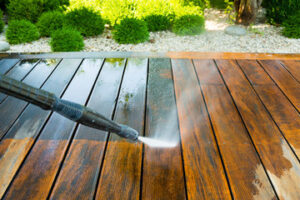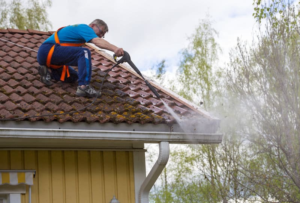Power Washing is a great way to eliminate stubborn stains and grime. It is often used in combination with cleaning chemicals that break down mold, mildew and grease stains.
What sets power washing apart from regular hose water is the heating element. The heated water loosens dirt and grime better and makes the job quicker. Visit https://www.certifiedsoftwash.ca/ to learn more.

Power washing, also known as high-pressure cleaning, is a technique where a spray of water is used at a very high volume (often exceeding 2,000 pounds per square inch, or psi). The force of the water loosens dirt, mildew, mold and other contaminants from surfaces such as sidewalks, patios, roofs, and concrete. It is a quick and effective way to remove stubborn buildup without the need for chemical cleaners. However, the pressure can damage surfaces if used incorrectly, such as stripping paint or damaging siding. Therefore, it is important to use the correct settings and techniques for each surface being cleaned.
Power washers can vary in their output, with household units being much less powerful than commercial units. The main difference is that a commercial power washer uses heated water in the high-pressure water stream, which allows it to more easily remove substances such as gum, graffiti, and moss. It is also capable of killing weeds and other unwanted plants.
The heated water also helps to speed up the cleaning process as it melts the ice and snow that accumulates on the surface being cleaned. This allows the water to flow more easily and quickly, which makes it ideal for outdoor cleaning. However, it is not recommended to power wash wood, vinyl siding, shingles, and other delicate exteriors, as the hot water can damage them.
When hiring a professional to perform a power wash on your home, be sure to ask about their experience and equipment. They should be able to provide you with references and examples of previous work they have performed. In addition, they should be insured and licensed to protect you in the event of an accident or property damage.
In addition to residential properties, power washing is an excellent choice for businesses that want to keep their customers and employees safe from bacteria and other contaminants. The process can also boost a company’s curb appeal and encourage customers to return. A building that is covered in dirt and grime can make it look run-down and unappealing, while a clean and bright space can make people feel welcome and eager to spend time there.
Water
The water used in power washing blasts away grime and dirt from various surfaces. It can effectively remove mildew, mold, moss, and other stubborn substances from surfaces. It is also a great way to get rid of debris, such as leaves, branches, and other organic matter. Adding a cleaning solution to the water enhances its effectiveness, removing even more substances from surfaces.
While many people use the terms “pressure washing” and “power washing” interchangeably, there are some important differences. The main difference is the temperature of the water. Pressure washing uses unheated tap water, while power washing pressurizes heated water. The hot water allows for a more thorough cleaning, but it can also damage heat-sensitive surfaces. For this reason, power washing is best for outdoor surfaces that can withstand the high-pressure water stream.
Adding detergent to the water enhances its cleaning power, making it easier to remove even more substances from surfaces. This makes power washing more effective than using a regular garden hose. However, it is important to remember that using a detergent increases the risk of pollution. This is because the detergent can wash away pollutants into storm drains and other waterways. It is therefore important to follow Best Management Practices (BMPs) during the power washing process.
Power washing can be done on a variety of surfaces, including wood, metal, concrete, and brick. It can also be used to clean vehicles, boats, and some interior surfaces. In addition, power washing can remove loose paint, algae, moss, mildew, and dirt from gutters, siding, roofs, and driveways.
If you are considering using power washing to sanitize your business, it is important to consult with a professional cleaning company. They will be able to advise you on the equipment and chemicals best suited for your needs. Additionally, they can help you develop a schedule for power washing that will ensure your business always looks its best.
It is also important to consider the impact that power washing will have on your water supply. If your well pump can’t handle the high-pressure water flow, it could cause damage to your home and property. Therefore, it is essential to test the equipment on a small, inconspicuous surface area before using it on your entire home or business.
Chemicals
Professional power washing uses a combination of high-pressure water and cleaning chemicals to remove dirt, mildew, mold, dust, oily substances, bird droppings, paint, mud, and other debris from surfaces like buildings, cars, and sidewalks. While some people are concerned that power washing is harmful for the environment, it’s actually an eco-friendly method of removing unwanted buildup. In addition, many power washing services also help to eliminate pests, such as spiders and cobwebs that can negatively impact the look of a building.
Using a professional power washing service can also reduce health risks for the building’s occupants. For example, mold and mildew can cause respiratory problems for people who are exposed to them on a regular basis. Power washing gets rid of these harmful particles and also makes it harder for them to grow in the future.
In addition, some of the chemicals used when power washing are effective at removing allergens that can impact the occupant’s health. For example, the chemical sodium hypochlorite is a powerful disinfectant that can be used to kill mold and mildew as well as other germs that may be present on surfaces. It can also be used to brighten surfaces and remove stains.
Other chemicals used when power washing include acidic chemicals that can be used to remove heavy oxides, salts, metal particles, and rust. Common acidic chemicals used when power washing include oxalic acid, citric acid, and hydrofluoric acid. These acids can be combined with detergents to create powerful solutions that can effectively clean even the dirtiest of surfaces.
If you’re looking for quality power washing chemicals, the Power Wash Store has all of the products you need to get the job done right. We offer a wide selection of foam boosters, surfactants, and more, so you can find the perfect solution for your specific needs. We also carry a wide range of cleaning detergents for both soft and hard wash applications, so you can find the best solution for your cleaning project.
Safety
Power washing is a great way to quickly and easily clean many types of surfaces. However, it’s important to take proper safety measures when using a pressure washer, especially if you’re not a professional cleaner. If you’re not careful, the high-pressure water can cut or irritate your skin. If this happens, you should seek medical attention immediately as the wound could become infected and lead to serious problems if left untreated.
Another type of safety issue to consider when using a power washer is electrical hazards. If you’re cleaning anything that’s electric, such as a power line, service feed or electric meter, it’s critical to keep the power washer at least 30 feet away from them. This will ensure that the spray doesn’t damage or injure you, someone else or their property.
Additionally, it’s essential to read the owner’s manual for your pressure washer before using it. This will provide you with information regarding your model’s specific safety features, as well as tips on how to use the machine correctly. In addition, it will give you a list of approved detergents that are safe to use with your power washer.
When hiring a professional power washing company, be sure to ask about their equipment and safety protocol. A reputable company will have commercial-grade equipment that is specifically designed for power washing. They’ll also have trained and experienced technicians who can safely and efficiently clean your property.
A professional power washing service is ideal for getting rid of dirt, grime, mildew, mold and stains on surfaces around your home or business. It’s a quick and efficient way to restore the appearance of your property and protect your investment.
If you want to hire a professional power washing service, look for one that offers free estimates and has a good reputation in the area. You’ll be glad you did! A thorough power wash can significantly improve the appearance of your home or business and protect it from damage. In addition, a professional power washing service will use the right amount of pressure and temperature to get the job done without damaging your property or injuring yourself.
